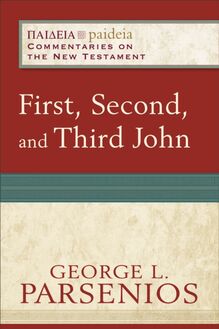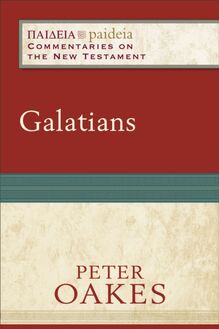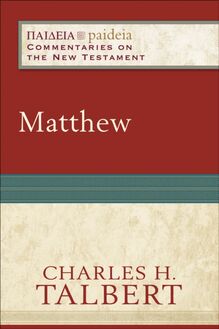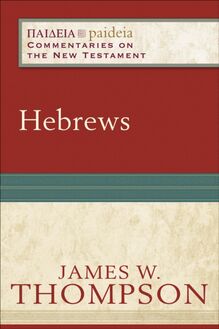-
 Univers
Univers
-
 Ebooks
Ebooks
-
 Livres audio
Livres audio
-
 Presse
Presse
-
 Podcasts
Podcasts
-
 BD
BD
-
 Documents
Documents
-
- Cours
- Révisions
- Ressources pédagogiques
- Sciences de l’éducation
- Manuels scolaires
- Langues
- Travaux de classe
- Annales de BEP
- Etudes supérieures
- Maternelle et primaire
- Fiches de lecture
- Orientation scolaire
- Méthodologie
- Corrigés de devoir
- Annales d’examens et concours
- Annales du bac
- Annales du brevet
- Rapports de stage
La lecture à portée de main
Vous pourrez modifier la taille du texte de cet ouvrage
Découvre YouScribe en t'inscrivant gratuitement
Je m'inscrisLuke (Paideia: Commentaries on the New Testament) , livre ebook
Découvre YouScribe en t'inscrivant gratuitement
Je m'inscrisEn savoir plus
Vous pourrez modifier la taille du texte de cet ouvrage
En savoir plus

Description
Sujets
Informations
| Publié par | Baker Publishing Group |
| Date de parution | 10 février 2015 |
| Nombre de lectures | 0 |
| EAN13 | 9781441221551 |
| Langue | English |
| Poids de l'ouvrage | 4 Mo |
Informations légales : prix de location à la page 0,0864€. Cette information est donnée uniquement à titre indicatif conformément à la législation en vigueur.
Extrait
G ENERAL E DITORS
Mikeal C. Parsons, Charles H. Talbert, and Bruce W. Longenecker
A DVISORY B OARD
†Paul J. Achtemeier
Loveday Alexander
C. Clifton Black
Susan R. Garrett
Francis J. Moloney
© 2015 by Mikeal C. Parsons
Published by Baker Academic
a division of Baker Publishing Group
PO Box 6287, Grand Rapids, MI 49516–6287
www.bakeracademic.com
Ebook edition created 2015
Ebook corrections 09.20.2018
All rights reserved. No part of this publication may be reproduced, stored in a retrieval system, or transmitted in any form or by any means—for example, electronic, photocopy, recording—without the prior written permission of the publisher. The only exception is brief quotations in printed reviews.
ISBN 978-1-4412-2155-1
Library of Congress Cataloging-in-Publication Data is on file at the Library of Congress, Washington, DC.
Translations from the Gospel of Luke (with occasional small adjustments) are from Martin M. Culy, Joshua J. Stigall, and Mikeal C. Parsons, Luke: A Handbook on the Greek Text , copyright © 2010 by Baylor University Press. Used by permission.
Unless otherwise indicated, all other Scripture quotations are from the New Revised Standard Version of the Bible, copyright © 1989, by the Division of Christian Education of the National Council of the Churches of Christ in the United States of America. Used by permission. All rights reserved.
Scripture quotations labeled ESV are from The Holy Bible, English Standard Version® (ESV®), copyright © 2001 by Crossway, a publishing ministry of Good News Publishers. Used by permission. All rights reserved. ESV Text Edition: 2007
Scripture quotations labeled KJV are from the King James Version of the Bible.
Scripture quotations labeled REB are from the Revised English Bible © 1989 Oxford University Press and Cambridge University Press.
Scripture quotations labeled RSV are from the Revised Standard Version of the Bible, copyright 1952 [2nd edition, 1971] by the Division of Christian Education of the National Council of the Churches of Christ in the United States of America. Used by permission. All rights reserved.
For Heidi
Contents
Cover
Series Page
Title Page
Copyright Page
Dedication
List of Figures and Tables
Foreword
Preface
Abbreviations
Introduction
Luke 1:1–4:13 Part 1: Jesus’s Origins and Training
Luke 1:1–4 Preface
Luke 1:5–56 Annunciations: John and Jesus
Luke 1:57–2:52 Birth and Training: John and Jesus
Luke 3:1–4:13 Beginning Jesus’s Public Ministry
Luke 4:14–9:50 Part 2: Jesus’s Mighty Words and Deeds in Galilee
Luke 4:14–6:49 Jesus’s Mission and Miracles and the Ingathering of His Followers
Luke 7:1–8:56 Jesus’s Marvelous Words and Deeds
Luke 9:1–50 Jesus’s Miracles and Mission and the Sending Out of His Followers
Luke 9:51–14:35 Part 3: Jesus’s Mighty Words and Deeds along the Way (Part 1)
Luke 9:51–11:13 Beginning the Journey
Luke 11:14–13:9 Jesus in Dialogue
Luke 13:10–14:35 More Healings and Parables
Luke 15:1–19:44 Part 4: Jesus’s Mighty Words and Deeds along the Way (Part 2)
Luke 15:1–32 The Character of God and the “Lost” Parables
Luke 16:1–17:10 The Use and Abuse of Wealth
Luke 17:11–18:30 Jesus’s Teaching about the Kingdom
Luke 18:31–19:44 Drawing Near to Jerusalem
Luke 19:45–24:53 Part 5: Jesus in Jerusalem: Teachings, Death, and Resurrection
Luke 19:45–21:38 Jesus in and around the Temple
Luke 22:1–23:49 The Meaning and Manner of Jesus’s Death
Luke 23:50–24:53 Jesus’s Burial, Empty Tomb, and Postresurrection Appearances
Bibliography
Index of Subjects
Index of Modern Authors
Index of Scripture and Ancient Sources
Back Cover
Figures and Tables
Figures
1. Gabriel Speaking to Mary, from the Church of the Annunciation
2. Jacopo Pontormo, Visitation , SS. Annunziata
3. Caesar Augustus Primaporta
4. View toward Bethlehem from Herodium
5. Grotto Star Church of the Annunciation
6. Tiberius, Emperor of Rome from AD 14 to 37
7. The Jordan River
8. Judean Desert
9. Mount of Temptation
10. Important Cities in Galilee
11. Synagogue Ruins
12. Western Shore of the Sea of Galilee
13. Modern Village of Nain
14. Mosaic below the Altar of the Church at Heptapegon/Tabgha Commemorating the Multiplication of the Loaves and Fishes
15. Galilee and Judea in the Time of Jesus
16. Typical Roman Road
17. Ruins of Chorazin
18. Copper Coin of Nero from Sepphoris
19. Mosaic of a Hen Gathering Her Chicks in the Chapel of Dominus Flevit
20. Millstones from Capernaum
21. Dominus Flevit Church, Which Commemorates Jesus Weeping over Jerusalem
22. Palestinian Vineyard
23. Arch of Titus, Erected in Honor of Titus’s Siege of Jerusalem
24. Grotto of Gethsemane, Traditional Site of Jesus’s Prayer at Gethsemane
25. Traditional Site of Jesus’s Burial
Tables
1. John the Baptist and Jesus Compared
2. Structure of Prologue
3. Comparing the Temptation Narratives
4. Conflict between God’s Agents and God’s People
5. List of Disciples in Synoptic Gospels and Acts
6. Progymnastic Topic of Double Encomium Synkrisis : Deeds
7. Shaping the Story of Jesus’s First Followers
8. A Triptych of Favorable Acts and Attitudes toward Jesus
Foreword
Paideia: Commentaries on the New Testament is a series that sets out to comment on the final form of the New Testament text in a way that pays due attention both to the cultural, literary, and theological settings in which the text took form and to the interests of the contemporary readers to whom the commentaries are addressed. This series is aimed squarely at students—including MA students in religious and theological studies programs, seminarians, and upper-division undergraduates—who have theological interests in the biblical text. Thus, the didactic aim of the series is to enable students to understand each book of the New Testament as a literary whole rooted in a particular ancient setting and related to its context within the New Testament.
The name “Paideia” (Greek for “education”) reflects (1) the instructional aim of the series—giving contemporary students a basic grounding in academic New Testament studies by guiding their engagement with New Testament texts; (2) the fact that the New Testament texts as literary unities are shaped by the educational categories and ideas (rhetorical, narratological, etc.) of their ancient writers and readers; and (3) the pedagogical aims of the texts themselves—their central aim being not simply to impart information but to form the theological convictions and moral habits of their readers.
Each commentary deals with the text in terms of larger rhetorical units; these are not verse-by-verse commentaries. This series thus stands within the stream of recent commentaries that attend to the final form of the text. Such reader-centered literary approaches are inherently more accessible to liberal arts students without extensive linguistic and historical-critical preparation than older exegetical approaches, but within the reader-centered world the sanest practitioners have paid careful attention to the extratext of the original readers, including not only these readers’ knowledge of the geography, history, and other contextual elements reflected in the text but also their ability to respond correctly to the literary and rhetorical conventions used in the text. Paideia commentaries pay deliberate attention to this extratextual repertoire in order to highlight the ways in which the text is designed to persuade and move its readers. Each rhetorical unit is explored from three angles: (1) introductory matters; (2) tracing the train of thought or narrative or rhetorical flow of the argument; and (3) theological issues raised by the text that are of interest to the contemporary Christian. Thus, the primary focus remains on the text and not its historical context or its interpretation in the secondary literature.
Our authors represent a variety of confessional points of view: Protestant, Catholic, and Orthodox. What they share, beyond being New Testament scholars of national and international repute, is a commitment to reading the biblical text as theological documents within their ancient contexts. Working within the broad parameters described here, each author brings his or her own considerable exegetical talents and deep theological commitments to the task of laying bare the interpretation of Scripture for the faith and practice of God’s people everywhere.
Mikeal C. Parsons Charles H. Talbert Bruce W. Longenecker
Preface
Paideia Luke represents my most recent stop in a lifelong journey with the Lukan writings. Luke’s version of the gospel has been my favorite of the four since childhood. My first encounter with Luke in an academic context occurred over thirty years ago in my first semester of seminary in a Greek exegesis course on Luke taught by John Polhill in Louisville, Kentucky, in which we worked carefully through Luke’s grammar with I. Howard Marshall’s then recently published commentary as our primary guide. My professional career began with a published version of my dissertation, The Departure of Jesus in Luke-Acts (1987), followed by Rethinking the Unity of Luke and Acts (with Richard I. Pervo, 1993), Body and Character in Luke and Acts (2006, 2011) and Luke: Storyteller, Interpreter, Evangelist (2007, 2014). A trilogy of works on Luke and visual art, Illuminating Luke (2003, 2005, 2007), cowritten with my wife, Heidi Hornik, was sandwiched between two handbooks on the Greek text of Acts (with Martin Culy, 2003) and Luke (with Martin Culy and Joshua Stigall, 2010). Three edited volumes explored the interpretation of Acts in the works of three twentieth-century scholars, Cadbury, Knox, and Talbert: North American Contributions to the Study of Acts (with Joseph B. Tyson, 1992); the treatment of Acts among Baptist interpreters, The Acts of the Apostles: Four Centuries of Baptist Interpretation (with Beth Barr, Bill Leonard, and Doug Weaver

Ebooks
First, Second, and Third John (Paideia: Commentaries on the New Testament)
L. Parsenios George

Ebooks
Etudes littéraires
First, Second, and Third John (Paideia: Commentaries on the New Testament)
L. Parsenios George
174 pages
English

Ebooks
John (Paideia: Commentaries on the New Testament)
A. Brant Jo-Ann

Ebooks
Religions
John (Paideia: Commentaries on the New Testament)
A. Brant Jo-Ann
273 pages
English

Ebooks
First and Second Peter (Paideia: Commentaries on the New Testament)
F. Watson Duane

Ebooks
Religions
First and Second Peter (Paideia: Commentaries on the New Testament)
F. Watson Duane
237 pages
English

Ebooks
James and Jude (Paideia: Commentaries on the New Testament)
John Painter

Ebooks
Religions
James and Jude (Paideia: Commentaries on the New Testament)
John Painter
222 pages
English

Ebooks
Galatians (Paideia: Commentaries on the New Testament)
Peter Oakes

Ebooks
Etudes littéraires
Galatians (Paideia: Commentaries on the New Testament)
Peter Oakes
138 pages
English

Ebooks
Luke (Paideia: Commentaries on the New Testament)
C. Parsons Mikeal

Ebooks
Religions
Luke (Paideia: Commentaries on the New Testament)
C. Parsons Mikeal
269 pages
English

Ebooks
Matthew (Paideia: Commentaries on the New Testament)
H. Talbert Charles

Ebooks
Religions
Matthew (Paideia: Commentaries on the New Testament)
H. Talbert Charles
385 pages
English

Ebooks
Hebrews (Paideia: Commentaries on the New Testament)
W. Thompson James

Ebooks
Religions
Hebrews (Paideia: Commentaries on the New Testament)
W. Thompson James
248 pages
English

Ebooks
Acts (Paideia: Commentaries on the New Testament)
C. Parsons Mikeal

Ebooks
Religions
Acts (Paideia: Commentaries on the New Testament)
C. Parsons Mikeal
371 pages
English
-
 Univers
Univers
-
 Ebooks
Ebooks
-
 Livres audio
Livres audio
-
 Presse
Presse
-
 Podcasts
Podcasts
-
 BD
BD
-
 Documents
Documents
-
Jeunesse
-
Littérature
-
Ressources professionnelles
-
Santé et bien-être
-
Savoirs
-
Education
-
Loisirs et hobbies
-
Art, musique et cinéma
-
Actualité et débat de société
-
Jeunesse
-
Littérature
-
Ressources professionnelles
-
Santé et bien-être
-
Savoirs
-
Education
-
Loisirs et hobbies
-
Art, musique et cinéma
-
Actualité et débat de société
-
Actualités
-
Lifestyle
-
Presse jeunesse
-
Presse professionnelle
-
Pratique
-
Presse sportive
-
Presse internationale
-
Culture & Médias
-
Action et Aventures
-
Science-fiction et Fantasy
-
Société
-
Jeunesse
-
Littérature
-
Ressources professionnelles
-
Santé et bien-être
-
Savoirs
-
Education
-
Loisirs et hobbies
-
Art, musique et cinéma
-
Actualité et débat de société
- Cours
- Révisions
- Ressources pédagogiques
- Sciences de l’éducation
- Manuels scolaires
- Langues
- Travaux de classe
- Annales de BEP
- Etudes supérieures
- Maternelle et primaire
- Fiches de lecture
- Orientation scolaire
- Méthodologie
- Corrigés de devoir
- Annales d’examens et concours
- Annales du bac
- Annales du brevet
- Rapports de stage





